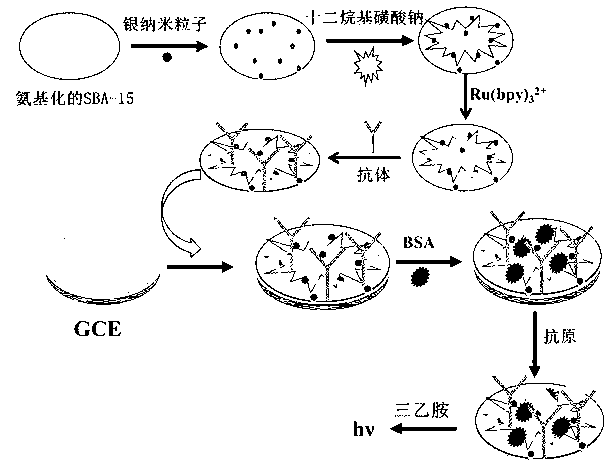Manufacture method and application of silver hybridization SBA-15 electrochemical luminescence immunosensor
A technology of luminescence immunity and electrochemistry, which is applied in the fields of chemiluminescence/bioluminescence, electrochemical variables of materials, and analysis through chemical reactions of materials, etc. problem, to achieve the effect of improving electron transfer efficiency, excellent synergistic sensitization effect, and short response time
- Summary
- Abstract
- Description
- Claims
- Application Information
AI Technical Summary
Problems solved by technology
Method used
Image
Examples
Embodiment 1
[0051] (1) Preparation of AgSBA-15 nanocomposite, the steps are as follows:
[0052] 1) Preparation of silver nanoparticles: add 48mL ultrapure water to the Erlenmeyer flask, add 1mL 50mmol / L AgNO under stirring 3 solution and 1 mL of 5% sodium citrate solution. Then, in above-mentioned solution, add a small amount of sodium borohydride solid, continue stirring 10min, solution turns brownish yellow, shows to form silver nanoparticle. Continue stirring until the color of the silver nanoparticle colloidal solution no longer changes. Centrifuge and store the supernatant in the dark;
[0053] 2) Preparation of AgSBA-15 nanocomposite material: Take 2mL silver nanoparticle colloidal solution and 4mg aminated SBA-15, shake for 24h, centrifuge, remove the supernatant to obtain AgSBA-15.
[0054] (2) Ru(bpy) 3 2+ -The preparation of AgSBA-15, the steps are as follows:
[0055] 5mg of sodium dodecylsulfonate was ultrasonically dissolved in 3mL of ultrapure water, AgSBA-15 was adde...
Embodiment 2
[0064] (1) Preparation of AgSBA-15 nanocomposite, the steps are as follows:
[0065] 1) Preparation of silver nanoparticles: add 48mL ultrapure water to the Erlenmeyer flask, add 1mL 50mmol / L AgNO under stirring 3 solution and 1 mL of 5% sodium citrate solution. Then, a small amount of sodium borohydride solid was added to the above solution, and the stirring was continued for 10 min, and the solution turned brownish yellow, indicating the formation of silver nanoparticles. Continue stirring until the color of the silver nanoparticle colloidal solution no longer changes. Centrifuge and store the supernatant in the dark;
[0066] 2) Preparation of AgSBA-15 nanocomposite material: take 2mL of silver nanoparticle colloidal solution and 5mg of aminated SBA-15, shake for 24h, centrifuge, remove the supernatant to obtain AgSBA-15.
[0067] (2) Ru(bpy) 3 2+ -The preparation of AgSBA-15, the steps are as follows:
[0068] 10 mg of sodium dodecyl sulfonate was ultrasonically diss...
Embodiment 3
[0077] (1) Preparation of AgSBA-15 nanocomposite, the steps are as follows:
[0078] 1) Preparation of silver nanoparticles: add 48mL ultrapure water to the Erlenmeyer flask, add 1mL 50mmol / L AgNO under stirring 3 solution and 1 mL of 5% sodium citrate solution. Then, a small amount of sodium borohydride solid was added to the above solution, and the stirring was continued for 10 min, and the solution turned brownish yellow, indicating the formation of silver nanoparticles. Continue stirring until the color of the silver nanoparticle colloidal solution no longer changes. Centrifuge and store the supernatant in the dark;
[0079] 2) Preparation of AgSBA-15 nanocomposite material: take 2mL silver nanoparticle colloidal solution and 6mg aminated SBA-15, shake for 24h, centrifuge, remove the supernatant to obtain AgSBA-15.
[0080] (2) Ru(bpy) 3 2+ -The preparation of AgSBA-15, the steps are as follows:
[0081] 15mg of sodium dodecylsulfonate was ultrasonically dissolved in...
PUM
 Login to View More
Login to View More Abstract
Description
Claims
Application Information
 Login to View More
Login to View More - R&D
- Intellectual Property
- Life Sciences
- Materials
- Tech Scout
- Unparalleled Data Quality
- Higher Quality Content
- 60% Fewer Hallucinations
Browse by: Latest US Patents, China's latest patents, Technical Efficacy Thesaurus, Application Domain, Technology Topic, Popular Technical Reports.
© 2025 PatSnap. All rights reserved.Legal|Privacy policy|Modern Slavery Act Transparency Statement|Sitemap|About US| Contact US: help@patsnap.com



